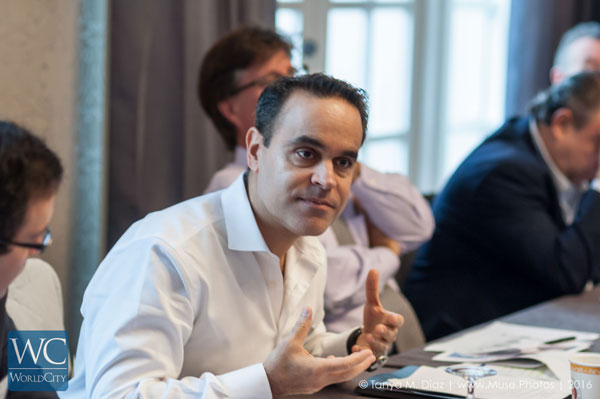E-Commerce in Latin America: Opportunities and Challenges
Latin America has tremendous potential for e-commerce but must overcome hurdles ranging from limited use of credit cards to a lack of online presence for many small businesses.
Those were some highlights from a discussion at WorldCity’s CEO Club led by Paul Tessy, CEO for DHL’s e-commerce division for Latin America & Canada, held Dec. 2, 2016, in Coral Gables.
Tessy opened his talk by e-commerce “the biggest trend in our lifetime,” noting “consumers want fast, free, and convenient.”
Even so, in Latin America, only about 2 percent of commerce now is digital, versus 14 percent in the United States, Tessy said. And just 10 percent of Latin Americans buy online, compared to more than two-thirds of U.S residents, studies show.
Limits to financial services hinder e-commerce
Part of the problem in Latin America is limited use of financial services. Roughly 30 percent of consumers in the region have credit cards, versus some 80 percent in the United States, Tessy said. And millions of Latin Americans still don’t have bank accounts, relying on cash for their basic needs, added Romaine Seguin, president of the Americas region for UPS.
“Is anyone taking the lead” to offer financial services to the unbanked and under-banked in Latin America?, asked Mary Young, director of the Ziff Career Center at the University of Miami’s Ziff Career Center.
It’s a process that is “slow, emerging and taking baby steps,” Tessy told the group of top executives.
Security concerns also hinder e-commerce in the region, including problems delivering unattended packages, said Martin Caminos, commercial director for Latin America and the Caribbean at Kraft Heinz. And there are problems too with “fraud and cash collection,” added Tessy.
Too few companies are digitally ready to conduct e-commerce anyway, especially small businesses. Even in the United States, only 40 percent of companies have websites nowadays, “which means 60 percent of companies have no online presence,” said Ricardo Villate, vice president of researcher IDC Latin America.
Developing new distribution strategies
Developing e-commerce also requires new strategies for distribution. In the United States, where logistics systems are more mature, market leader Amazon has found ways to bring goods to households fast – even if that means storing double the inventory in warehouses nearby to ensure quick access to last-mile delivery.
“Amazon has become a massive search engine and holds 50 percent of market share,” a share so large that it can afford to offer free delivery to consumers, Tessy said.
Small businesses benefit from Amazon’s massive platform to cut their delivery costs too, even as small firms continue to compete with Amazon, Tessy said. “Amazon controlling product visibility means they can control business,” he said. Referencing a term that combines cooperation and competition, he said, “It’s important to have co-opetion: play with them, compete with them.”
Outsourcing the “Last Mile”?
For some industries, it may make sense for last-mile delivery to use car-sharing services such as Uber or Lyft or even to fund growth through crowd- sourcing – at the very least as “fad, niche or transformative models,” Tessy said.
But other more industries could clash with those delivery channels. “With sectors such as pharmaceuticals, the visibility and reliability required might not be a fit for Uber and Lyft model,” said UPS’ Seguin.
Tessy described Uber and Lyft as new “informal” models, compared to more traditional delivery methods. But Andres Graziosi, president for Novartis Latin America, noted definitions are shifting too: “I’m not sure we can say a taxi is formal and Uber is informal. There is a point where consumers can’t distinguish.
From a branding standpoint, “consumers are most likely unaware and not sure who delivers what,” added Xavier Muffragi, president and CEO for ClubMed North America.
Pursuing innovation alliances
DHL is keen on innovative alliances to grow. In May, it joined with carmaker Audi to locate vehicles via GPS and have consumer’s orders placed directly inside their car trunks.
Innovation is vital at every step in the supply chain, as Starbucks shows, said Joseph Ganitsky, director of UM’s Center for International Business and Education Research (CIBER). “Starbucks has largest Facebook user community. Coffee is not related to technology, but investing is imperative and must be aggressive. It cannot be disrupted,” Ganitsky said.
Outlook for Latin American e-commerce
To develop e-commerce in Latin America, companies still have a big marketing job to do. “Amazon has spent 30% of revenue trying to get consumer into the digital space,” Tessy said.
Companies expanding in the region must be open to labor unions, cultural differences and even contrasts in transport systems among nations. Even decisions on whether to ship by air or land vary widely among markets in Latin America. Said Tessy: It’s “geography and road infrastructure that determine delivery network.”
Yet multinationals may have an edge in developing e-commerce, because consumers recognize their investment in worldwide security and anti-fraud systems: “They want DHL, they want UPS,” Tessy said.
CEO Club is one of four event series put on by WorldCity to bring together executives in greater Miami on international business topics. The CEO series is sponsored by the University of Miami School of Business Administration, Berkowitz Pollack Brant and The Conroy Martinez Group.





